Fourth of July Porch Pots
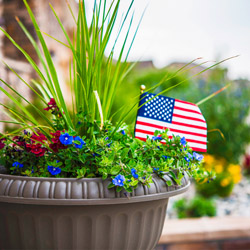
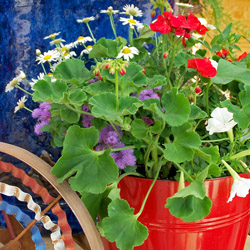

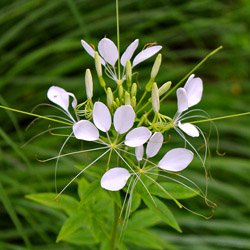
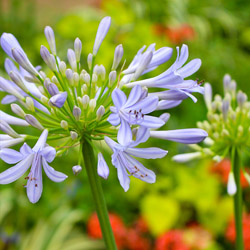 A porch pot can be a beautiful accent to any entryway, and with a bit of patriotic flair, you can easily style a Fourth of July porch pot as a decorative highlight for all your summer festivities. By carefully designing the pot and the plants it showcases, it can burst into festive glory just in time for the holiday.
A porch pot can be a beautiful accent to any entryway, and with a bit of patriotic flair, you can easily style a Fourth of July porch pot as a decorative highlight for all your summer festivities. By carefully designing the pot and the plants it showcases, it can burst into festive glory just in time for the holiday.
Beyond the Porch
A porch pot is traditionally an elegant container positioned at the main front entryway, but for summer porch pots it’s fun to look beyond the porch for where to show off your festive container. Where will you be greeting guests and entertaining during the summer months? Any gathering spot can be made more seasonal with the right porch pot, so consider placing one or more pots…
- In the corners of a deck or patio
- Spaced along a bare section of fence
- On stairs leading up to a deck or porch
- Framing an outdoor kitchen or grill area
- Accenting a pool surround
- As an outdoor table centerpiece
Wherever your pots can be seen, they’re sure to add a patriotic bit of color to give a party-like atmosphere to your outdoor living spaces.
Picking the Pot
When choosing a container for a Fourth of July pot, first consider where the pot will be located and choose an appropriate size for that location. Be mindful that the pot will not block walkways or cause a trip hazard on stairs, and be sure it is sturdy enough to hold up the plants you want to showcase.
The pot style can vary, and choosing a pot with patriotic colors can add instant flair to your decorative arrangement. Red, white, or blue pots are always popular choices, or the pot could be painted with a patriotic theme such as stars and stripes. Spattering a white pot with red and blue is a more subtle but festive option, or larger polka dots could be a bold and colorful statement. To honor a military connection, consider a pot with a camouflage pattern, or choose a more demure, understated pot to let the plants be the true stars of the arrangement.
Top Fourth of July Flower Picks
You can add any type of flowers you’d like to a Fourth of July porch pot, but red, white, and blue blooms are always favorites. Fortunately, there are many flower choices that can work into this color palette, including…
- Red – Petunia, zinnia, verbena, cardinal flower, impatiens, geraniums, nasturtium
- White – Zinnia, dahlia, geranium, verbena, daisy, petunia, cleome, vinca, snapdragon, impatiens
- Blue – Agapanthus, clematis, scabiosa, verbena, wishbone flower, lobelia, salvia, ageratum
In addition to bloom colors, you can also consider flower shape and opt for star-shaped blooms such as lilies, pentas, or star jasmine. Tall, flowing grasses with arcing plumes are another elegant option that mimics the gracefulness of fireworks. The round balls of allium and the spikes of salvia are other interesting shapes popular in patriotic displays.
Whichever plants you choose for your pot, remember the thriller-filler-spiller rule of thumb to create a lush, eye-catching arrangement, and it will sure to be a stunning decoration.
Planting Your Pot
Ideally, a Fourth of July porch pot should be planted several weeks before the holiday or any summer event so the plants have a chance to settle and fill in the pot before the celebration. If you’ve chosen a larger pot, add a layer of rocks or a brick or two to the bottom of the pot so it is properly weighted and will be less likely to tip over if accidentally bumped. Choose high quality potting soil to give each plant the proper nourishment, and ideally choose plants that all have similar sunlight and watering needs so they will thrive together.
Summer Porch Pot Care
Once planted, you will need to give your Fourth of July porch pot the proper care so it continues to look its best. Positioning the pot on a moveable stand or casters will help you be sure it has adequate light even as shadows shift from week to week, and rotating the pot will ensure the plants grow evenly. Water the pot appropriately, bearing in mind that smaller pots will need more frequent watering, especially on hot summer days. Fertilizing should not be necessary if you’ve used high quality potting soil, but if needed, fertilize sparingly to avoid burning roots or causing uneven growth. As the plants get taller, stake them if necessary, and protect the pot from sudden summer storms so it is not tipped or flooded.
Decorative Accents for a Fourth of July Porch Pot
It’s easy to add a bit of holiday flair to the pot if you choose decorative stakes with a red, white, and blue theme. Miniature flags are a popular choice, or you can find metallic sprays or faux firework rockets that will add a fun touch to the arrangement. Pinwheels are another great option that add a bit of movement to the pot.
Tying a ribbon around the pot can also add a holiday touch. Choose red, white, or blue ribbons, or opt for a rustic theme with gingham or checked patterns. Gold ribbons can also be a meaningful way to honor military members and deployed troops.
Be creative and fun with decorative accents for your porch pot, and it will be an eye-catching, attractive arrangement and a focal point for all your summer holiday entertaining.
Plant a Patriotic Flower Garden
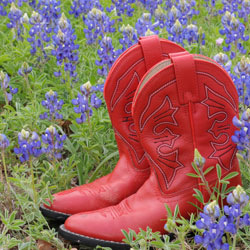

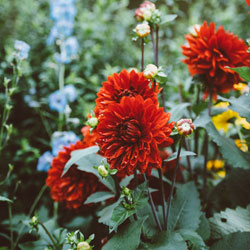
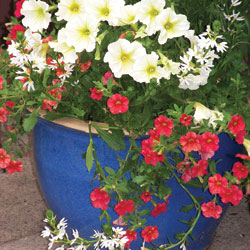 A patriotic flower garden can be a great way to show off your national pride, support a military serviceman or servicewoman, or just add decorative flair to your yard or landscaping for summer holidays. With careful steps, your flower garden can be filled with red, white and blue pride for the entire neighborhood to enjoy.
A patriotic flower garden can be a great way to show off your national pride, support a military serviceman or servicewoman, or just add decorative flair to your yard or landscaping for summer holidays. With careful steps, your flower garden can be filled with red, white and blue pride for the entire neighborhood to enjoy.
When to Be Patriotic
While a red, white and blue flower garden can be enjoyed any time from early spring through late fall, these color combinations are more popular for celebrating summer holidays. From Memorial Day in late May through Flag Day (June 14), Independence Day (July 4) and even to Labor Day in early September, a patriotic flower garden can be the perfect decoration. These designs are also popular for summer barbecues, family reunions and other celebrations. Whenever you want your garden to be in its full, colorful bloom, however, be sure to choose suitable flowers with planting times and growth habits that ensure they look their best on the desired date.
Planning the Flower Garden
You can turn an existing flowerbed into a patriotic display or plan an entirely new flower garden to show your patriotic pride. Regardless of which flowerbed you use, there are different factors that should be considered to make sure the bed looks its very best.
- Size
Any size flower garden can show patriotic colors, but it needs to be carefully designed so all the colors are seen equally. Larger flowerbeds are easier to design colorfully, though it does also depend on where the flower garden is positioned. If the garden is in a very visible space, a smaller garden can be just as delightful as any larger flowerbed. For mini gardens, patriotic plantings may be constructed in a single pot with one thriller, one filler and one spiller plant to give the arrangement balance and movement. - Shape
Any flowerbed shape can be patriotically designed, whether it is a small, narrow bed, a larger round bed, a spot beneath a tree or alongside a house or fence. A curved bed might lend itself well to a “waving flag” type of design, while a round bed could become a star pattern. Simple color blocking can be used in any bed shape to create a patriotic color scheme. - Location
It is important that a patriotic flower garden be visible, not only for your enjoyment, but also for your guests, whether those guests are neighbors passing by your yard, visitors enjoying a barbecue party or anyone else who may see the bed. Properly positioned, the flower garden can be a welcome statement for your yard as well as a focal point for your landscape. - Design
There are many beautiful designs for patriotic flower gardens. You could create an image in flowers, such as planning colors and arrangements to mimic an American flag, or you might create star shapes with the different colors. Simply balancing patriotic colors in different tiers can be a lovely option as well.
Coloring Your Patriotic Flower Garden
There are many different and beautiful ways to incorporate red, white and blue into a patriotic flower garden, both with plants as well as decorative accents.
- Red
Popular red flowers for a patriotic bed include astilbe, gerbera daisies, cockscomb, dianthus, begonias, dahlias, poppies, camellias, impatiens, geraniums, petunias, salvia and ranunculus. Choose flowers with bold, rich red shades that aren’t too pale or pinkish. Other red accents could include red brick edging, a bright red gazing ball, red hummingbird feeders or even red mulch such as wood chips or lava rock. - White
White stone edging, a short decorative fence or river rocks can frame a patriotic flower bed, and there are many stunning white flowers to fill that bed. Heliotrope, astilbe, petunias, gerbera daisies, jasmine, camellias, peonies, chrysanthemums, yarrow, ranunculus, anemone, vinca, dahlia and hyacinth are just a few options that can add a burst of white to the bed. You can also consider red and blue flowers that have white accents in their blooms. - Blue
It can be difficult to find blue flowers with the proper rich hue for a patriotic flower garden. Options include cornflower, flax, globe thistles, periwinkle, salvia, harvestbells, desert bluebells, sweetpea and lobelia. To add more blue tones, consider a blue gazing ball, ceramic blue bird bath or blue containers and pots in the proper blue shades rather than having too much purple-like coloration.
More Tips for a Patriotic Flower Garden
There are many other fun ways to give your flower garden even more patriotic flair. Choose flower types that have star shapes in their blooms or coloration, or opt for big, bold blooms that resemble bursts of fireworks. Adding ornamental grasses to the bed can give it a sense of fireworks as well, or you can go vertical with a colored trellis or arbor, such as a blue structure to support red and white flowers. Add flag stakes to decorate the bed and there will be no mistaking its patriotic nature.
To be sure your garden looks its very best right before a party, holiday or other celebration, trim away excess greenery so as much red, white and blue color is exposed as possible. Also trim, prune or pinch away any blooms that have faded or discolored, especially white blooms that may be showing brown edges that can detract from the flowerbed’s beauty. With a little care and attention, your patriotic flower garden will be brimming with colorful spirit all summer long.
Easter Plant Guide
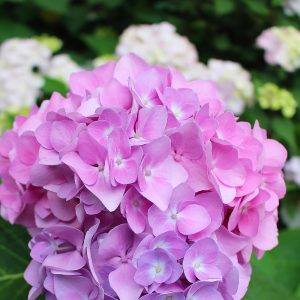
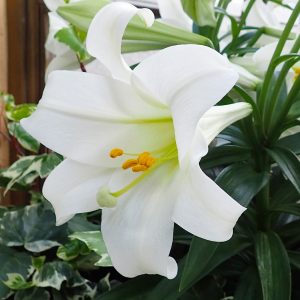

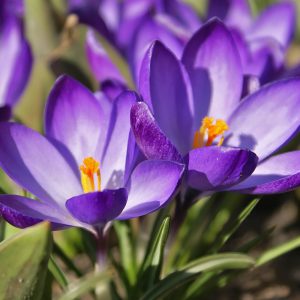 Easter is a season of rebirth and renewed growth in the garden, and many beautiful plants can be lovely gifts to celebrate this spring holiday. Whether you want to give plants as thoughtful Easter gifts to friends, family members, neighbors, coworkers, caregivers, teachers, or any other special person, or even just enjoy the plants yourself, this Easter plant guide can help you choose the best options to spread seasonal cheer.
Easter is a season of rebirth and renewed growth in the garden, and many beautiful plants can be lovely gifts to celebrate this spring holiday. Whether you want to give plants as thoughtful Easter gifts to friends, family members, neighbors, coworkers, caregivers, teachers, or any other special person, or even just enjoy the plants yourself, this Easter plant guide can help you choose the best options to spread seasonal cheer.
Before You Choose a Plant
When giving a plant as a gift for any occasion, consider the recipient’s needs and preferences to be sure the gift will be suitable. Is that someone special able to care for a larger potted plant, or would a smaller one be more appropriate? What are that person’s favorite plants or flowers, or what are their favorite colors? Do they have an interest in cultivating houseplants, or are they more suited to receive a potted plant that can be added to their garden or landscape?
By taking those factors into consideration, you can choose the best Easter plant to be a welcome and thoughtful gift, one that will demonstrate the season’s beauty and nature’s freshness long after Easter weekend has passed.
Top 10 Easter Plants
There are many choices for attractive Easter plants that can be wonderful gifts and attractive seasonal accents. The top plants associated with spring and Easter include…
- Easter Lily
The large, upright Easter lily plant is always a favorite in spring with its bold foliage and peaceful white blooms. This plant can come in single or multiple blooms depending on the size of the plant and is typically offered as a potted plant. - Lily-of-the-Valley
The delicate bell-shaped flowers of lily-of-the-valley are an early sign of spring, and these plants can be grown in containers or planted as groundcovers in areas with partial shade. They will spread rapidly, filling in an area with their fragrant blossoms. - Calla Lily
These elegant blooms have a modern, sophisticated flair and are available in both large and miniature varieties. Calla lilies come in many colors, from rich purples, reds, and pinks to paler shades of yellow, ivory, and white, offering choices for anyone’s favorite hues. - Daffodil
A classic spring flower, the sprightly daffodil is an early blooming bulb and easy to grow in containers of different sizes, making it ideal for a gift. Available in yellows and whites, this is a cheerful flower always suitable for Easter, and can be a cut flower as well. - Tulip
Tulips come in a wide range of amazing colors and variegated shades, so it is easy to find the perfect potted tulip bulb or cut tulips for anyone’s tastes. There are even variations in size and petal shape for even more uniqueness for these stunning flowers. - Miniature Rose
Roses are familiar flowers, and miniature rose bushes are a fun Easter gift for anyone who loves their beautiful aroma. Different colors and rose varieties are available for these potted gifts, and they make great houseplants year-round. - Crocus
Another classic, early-blooming spring bulb, crocuses are compact and ideal for containers, either alone or paired with other spring bulbs. Available in several different colors, these flowers can create a lovely pot for a gift arrangement. - Hydrangea
Large, bold flowers with multiple blooms in a bundle, hydrangeas are stunners as cut flowers as well as planted in the landscape. These flowers come in calming spring shades of pastel pink, blue, and purple, as well as soft white hues and pale greens. - Hyacinth
A colorful bulb that blooms in upright bundles, hyacinths come in bold colors as well as more classic spring shades. These are great flowers for containers and can easily be planted to bring color to the landscape for many years to come. - Easter Cactus
A close relative of the Christmas cactus, this succulent features fleshy, lobed foliage and colorful blooms that appear in spring. This plant is an easy-care choice and can live for many years in suitable containers.
While these plants may be classic options for Easter, any plant can be a wonderful gift to share the joy of the season or to decorate a table, mantle, windowsill, entryway, or other household niche. Another option, particularly in regions with long, severe, winters, is to give seeds as an Easter gift so they are ready to be planted as soon as spring does arrive, even if the holiday is too early for planting.
Giving a Plant for Easter
No matter what plant, bulb, or flower may be used as an Easter plant, a bit of decorative flair can tie it to the season and make it more festive. Opt for a fun, spring-themed pot in a bright hue, or one with a whimsical floral or Easter pattern. Adding an Easter ribbon or plant pick to an arrangement can give it a holiday touch, or pair the gift with additional items, such as a new pair of garden gloves, ergonomic hand tools, or a garden knee pad for even more usefulness as the gardening season warms. Be sure the plant itself is in prime condition just before being presented as a gift by pruning away any spent foliage or bruised blooms, and water it a day or two before the presentation so it is as fresh and lush as possible. This extra care will ensure the plant is healthy and able to be enjoyed for the entire Easter weekend, and the good thoughts and best wishes that accompany it will last long past the holiday.
Trackable Tools
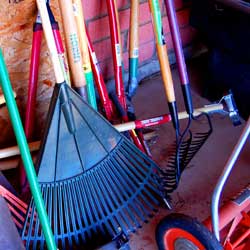 It’s the beginning of a new gardening season. Hopefully you took out last year’s journal in January or February and reviewed your notes on what you wanted to change, improve, experiment with or eliminate from your garden and landscape. Now is the time to begin implementing some of those great ideas, and it starts with having the right tools.
It’s the beginning of a new gardening season. Hopefully you took out last year’s journal in January or February and reviewed your notes on what you wanted to change, improve, experiment with or eliminate from your garden and landscape. Now is the time to begin implementing some of those great ideas, and it starts with having the right tools.
Where Do Your Tools Go?
One common problem in the garden is misplaced tools. We’ve all found hand tools in the spring that were inadvertently thrown in the compost pile or left under a shrub during fall cleanup. Many of us have spent time we didn’t have to spare walking in circles, looking for the shovel that we just had in our hand. It was laid down for a moment and seemed to disappear. Tools can easily disappear on a crowded workbench or in a cluttered shed, or they may even end up in a brush pile or other unlikely location.
When tools are lost, not only are our gardening chores impacted, but the tools can be damaged by exposure or accidental damage if they’re dropped, run over with a mower or otherwise subjected to inadvertent abuse. This can mean we no longer have the tool we need when we need it most, and we have to make a trip to the garden center to replace a tool – using time and money our gardening budget may not have.
Finding Your Tools
Let’s do things differently this year. Let’s save time, money and our precious tools. Resolve to only buy new hand tools with bright colored handles that are easily seen from afar and stand out to be picked up after a long day in the garden. If you already have a good selection of tools that you love and wish to keep track of, simply cover the handle with a bright colored spray paint on a sunny spring day, or wrap the handles with brightly colored tape or other coverings to make them more visible.
Similarly, take the time to clean out and declutter your garden shed, tool boxes and workbenches, making sure there is a safe, appropriate place to store every tool. If each tool has a place, you’ll be able to see at a glance when a tool may be missing and you can find it quickly before you’ve forgotten where you saw or used it last.
You and your garden will be glad you did!
Size Up Your Site, The First Step In Planning Your Landscape
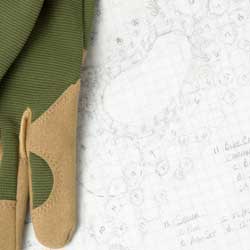 Whether you plan your garden from start to finish or use a professional designer, a few simple steps can help you assess your property’s potential to develop the landscape of your dreams. By getting involved in the landscape design process, you can address practical problems, structure your outdoor living space and develop a plan that will reflect your taste and lifestyle.
Whether you plan your garden from start to finish or use a professional designer, a few simple steps can help you assess your property’s potential to develop the landscape of your dreams. By getting involved in the landscape design process, you can address practical problems, structure your outdoor living space and develop a plan that will reflect your taste and lifestyle.
Surveying Your Site
Every yard, garden and landscape site will have differing light conditions, grade changes, varying soil conditions and existing plants and structures to consider when planning changes and expansions. Using a loose-leaf binder, take notes on each of the following:
Overall:
- What are your favorite spots in your yard and why? What your least favorite and why?
- In landscapes, do you generally prefer open on enclosed spaces?
- What existing plants do you want to preserve, and which do you want to remove?
- What is the architectural style of your home? What is your decorating style?
- Are you planning any additions to your home that may take away yard space?
- Do you want special areas for children, entertaining, pets, recreation, vegetable gardening, water features or composting?
- What is your time frame? Do you want a short-term or long-range plan?
- Which building materials do you like – brick, wood, stone, pavers, etc.?
- Is your outdoor lighting adequate for your use?
- Do you need to screen an area for wind, noise or an unwanted view?
- What is you landscaping budget (both short- and long-term)?
- How will your landscape use change over time, such as when children grow up?
Specific Areas:
- What is the light condition of the area? How does it change seasonally?
- How is the soil – well-drained, poor, heavy clay, poorly drained, etc?
- What are the dimensions of a confined area that could affect plant size?
- What are your favorite plants or types of plants?
- Would you like a garden accent or other feature in this area (trellis, arbor, sculpture, bench, pond, etc)?
- What is the pH and general condition of the soil?
Once you have taken adequate notes, you’ll have a much better understanding about the overall layout of your landscaping site. This can help you plan the best options without making costly or time-consuming mistakes, such as planting the wrong tree that will outgrow a corner in a few years, or choosing building materials that won’t stand up to your climate.
More Tips for Landscape Surveying
You can never have too much information at your fingertips when you are surveying your site for landscaping changes. More techniques that can give you all the information you need include…
- Photographing your property. Snapshots can reveal what the eye may overlook, and can be useful to show others to get their unique perspectives. Take views from your house and various areas of your property. Include photos from different times of day.
- Measure everything and mark it on a map. You can use graph paper to create a simple sketch that will show dimensions so you can properly size your landscaping plans.
- Make a sketch that shows what is existing (plants & structures) and where it is located. This will help you figure out what features you want to preserve, what you may want to expand and what you would rather remove and how the space will change.
Still need help? Bring your information in – we can help you choose the best plants, accents and accessories suitable to your needs, style and budget for the landscape of your dreams!
Attracting Birds to Your Garden
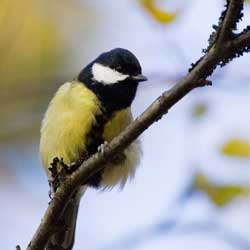 One of the benefits of a garden is the wildlife it attracts, and birds are some of the most popular garden wildlife. Most birds are voracious eaters that are glad to keep the insect population down, and may eat 500-1,000 insects in one afternoon. This makes them ideal for natural (and free!) pest control. Anything you can do to attract birds will make your garden healthier and you’ll be entertained by their feeding antics along the way.
One of the benefits of a garden is the wildlife it attracts, and birds are some of the most popular garden wildlife. Most birds are voracious eaters that are glad to keep the insect population down, and may eat 500-1,000 insects in one afternoon. This makes them ideal for natural (and free!) pest control. Anything you can do to attract birds will make your garden healthier and you’ll be entertained by their feeding antics along the way.
Fortunately, it is easy to attract birds to your garden if you meet their needs for food, shelter, water and overall habitat variety.
Food
While birds will certainly eat insects and may munch on seeds, berries and fruits in the garden, consider placing a variety of bird feeders in your garden to entice even more birds to visit. Platform feeders attract ground birds, hanging feeders are for perching birds and suet holders attract insect-eating birds. Suet is especially important during the winter as this helps birds maintain their body temperature by adding fat to their diet. Hang plastic mesh bags of suet or pinecones dipped in suet (or peanut butter) from the limbs of trees.
For your other feathered guests, white millet and black oil sunflower seeds will attract the most common seed-eating birds and can be sprinkled directly on the ground or added to feeders. Add other species-specific seed like Nyjer (thistle) seed (to attract goldfinches, pine siskins and purple finches) or peanuts (to attract chickadees, jays and tufted titmice) to your buffet. Various gourmet seed mixes are also available like Lyric Supreme, Delight, Chickadee, Woodpecker and Finch Mixes, each of which is blended with specific birds in mind and includes the foods those birds like best.
Shelter and Nesting Sites
Birds feel more secure if they have shelter to protect themselves from the weather and other predators. Plant native trees and shrubs birds will easily recognize as suitable shelter. If your landscape is young and doesn’t include much shelter for birds, don’t worry. Consider building a brush pile or adding a loose woodpile to the yard and birds will happily take advantage of it.
You may also want to add nesting boxes or bird houses and other materials for birds to raise their young. This should be done in late winter or early spring just as birds are beginning to look for nesting sites. Clean houses or boxes after each nesting season.
Water
One of the most important things to include in your bird-friendly garden is water. This is especially true during the winter months. Use a bird bath heater to keep water from freezing. Ideal water sources are 2-3 inches deep and 3 feet off the ground to keep visiting birds safer from prowling predators. Moving water is a magnet for most birds and will attract them from great distances for a drink or bath. A mister, dripper or circulating pump can be added to a bird bath or other water feature during most of the year, but take care to winterize the equipment properly so it does not freeze and break during the coldest months.
Habitat Variety
Because birds live in many different habitats, the variety of plant material you can offer in your backyard will determine how many birds are attracted to your garden. Consider native plants, plants with berries, fruits, sap and nectar for year-round food sources as well as nesting materials. Plan your landscape in tiers and flowing, connected beds so birds can move around easily, and include a variety of both deciduous and evergreen plantings so birds can find the habitat useful year-round.
We carry a complete line of bird feeders, houses, seed mixes and suets as well as garden accents; all the accessories and plants you will need to start attracting birds to your backyard. Stop by today!
Winter Interest in the Garden
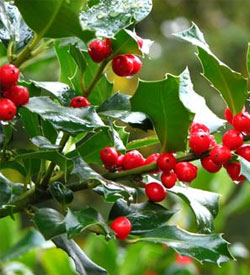 Many gardeners think of the fourth season as a time for rest, but winter can be interesting and fun to plan for a bold, appealing landscape. While most of us plan our landscapes for bloom times in spring and summer, there are many plants offering color and texture appeal for the cold season landscape.
Many gardeners think of the fourth season as a time for rest, but winter can be interesting and fun to plan for a bold, appealing landscape. While most of us plan our landscapes for bloom times in spring and summer, there are many plants offering color and texture appeal for the cold season landscape.
Winter Beauty in Your Landscape
Winter is a time of special beauty and interest. Berries sparkle on shrubs under a layer of frost and ice, while other shrubs have shades of bronze leaves that cling and rattle in winter breezes. The leafless branches of larger trees cast dramatic shadows across the freshly fallen snow. Bark hidden by the leaves of summer stands out gorgeously in the winter. Barks of silvery gray, white, green, yellow, purple or red hues add a burst of color when the landscape is covered in white. Even barks that are deeply fissured, sleek as satin, peeling in thin layers or curiously pocked by a pitted surface give interest to a wonderful winter landscape. Dried grasses stand out in bright contrast against the backdrop of dark evergreens, shaking snow off their delicate heads. There is even the surprising yellow ribbon-like blooms of witch-hazel which flower in mid-winter or the delicate lavenders and blues of tiny species of crocuses under the snow. Pansies are also a great addition for late-season winter color in your flowerbeds. Everywhere you look, there can be beauty in the winter landscape.
Top Plants for Winter Interest
Many different plants offer interesting features that reach their full potential in the winter landscape. Popular options include…
- Paperbark Maple (Acer grisium)
- Threadleaf Japanese Maple (Acer palmatum dissectum)
- Red Chokeberry (Aronia arbutifalia)
- Shagbark Hickory (Carya ovata)
- Blue Atlas Cedar (Cedrus atlantica ‘Glauca’)
- Harry Lauder’s Walking Stick (Corylus avellana ‘Contorta’)
- Winter Dephne (Daphne odora)
- Common Snow Drops (Galanthus nivalis)
- Wintergreen (Gaultheria procumbens)
- Christmas Rose (Heleboris niger)
- Chinese witch-hazel (Hamamelis mollis)
- Winterberry Holly (Ilex verticillata) Need female and male plant for berries
- Christmas fern (Polystichun acrostichoides)
- Common Camellia (Camellia japonica)
- Heathers/Heaths
Not sure which plants will offer the beauty you want to see all winter long? Our experts are always happy to help you plan the best landscape design for all four seasons, so come in and share your ideas today and we’ll help you be prepared for an amazing winter landscape.
Low Light Houseplants
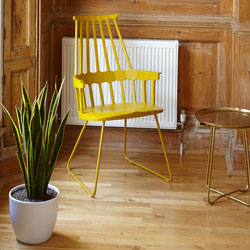 Plants brighten up any room, help clean the air and bring a bit of nature inside, but indoor spaces rarely have the same levels of bright, natural light many plants enjoy in their native habitats. Without adequate light, a plant’s foliage may be dull or turn yellow or brown, growth will be slow and flowers may fail to bloom. Choosing low light houseplants is an ideal solution for any indoor space, and there are many beautiful plants that can thrive in a dim environment.
Plants brighten up any room, help clean the air and bring a bit of nature inside, but indoor spaces rarely have the same levels of bright, natural light many plants enjoy in their native habitats. Without adequate light, a plant’s foliage may be dull or turn yellow or brown, growth will be slow and flowers may fail to bloom. Choosing low light houseplants is an ideal solution for any indoor space, and there are many beautiful plants that can thrive in a dim environment.
20 Best Houseplants for Low Light
There are many reasons to opt for low light houseplants. Some rooms, such as bedrooms and bathrooms, generally have lower than average light levels. Some homeowners use window shades, blinds or curtains for temperature control, which reduces the light available for indoor plants. Even bright rooms may have dim corners or shadowed spaces where light isn’t as intense. The exposure of any window also affects the sunlight it brings indoors, with north and west windows generally having lower light than south and east windows. Changing seasons also changes how much sunlight comes through any window, with less light available to indoor plants in fall and winter. Fortunately, there are many outstanding houseplants that can grow well in lower light conditions. While the best plants for your home will also vary based on humidity conditions and the care you can provide, houseplants that don’t mind lower light include:
- Begonia (Begonia)
- Bromeliads (Aechmea)
- Cast Iron Plant (Aspidistra)
- Chinese Evergreen (Aglaonema)
- Corn Plant (Dracaena fragrans)
- Dumb Cane (Dieffenbachia)
- Heartleaf Philodendron (Philodendron hederaceum)
- Lucky Bamboo (Dracaena)
- Maindenhair Fern (Adiantum)
- Parlor Palm (Chamaedorea elegans)
- Peace Lily (Spathiphyllum wallisii)
- Peperomia (Peperomia)
- Ponytail Palm (Beaucarnea recurvata)
- Pothos (Epipremnum aureum)
- Prayer Plant (Calathea)
- Rubber Plant (Ficus elastica)
- Snake Plant (Sansevieria)
- Spider Plant (Chlorophytum)
- Sword Fern (Polystichum munitum)
- ZZ Plant (Zamioculcas zamiifolia)
These are just a few of the most widespread, popular indoor plants that can do well with lower light levels. Check at your local nursery or garden center for additional varieties that are adapted to your region’s climate, especially during the winter months when houseplants are much more widely available.
Caring for Low Light Houseplants
It is important to note that whatever type of houseplant you choose, a designation as “low light” does not mean the plant can thrive in darkness. All plants need some light, but low light plants can still thrive in indirect or filtered light rather than several hours of bright sunlight each day. To give your low light plant the very best indoor habitat, you will also need…
- A proper pot or other container.
The pot will need to be the right size for the plant and its anticipated growth, without being too big or too small. Adequate drainage is also essential to prevent root rot and other care difficulties. - Suitable soil or potting mix.
Garden soil has too many contaminants to be good for houseplants, but choose a soil with good nutrition for the type of plant it will nurture. Add coir, peat or other potting material if necessary to adjust the soil composition. - Proper watering.
Inadequate water or overwatering can both be deadly for houseplants. Know what water your plant needs and adjust the watering schedule based on the plant’s size and seasonal needs throughout the year. Watering gauges or automatic watering tools can help you be sure you aren’t drowning or drying out your houseplants. - Regular feeding.
Because houseplants rely on the same soil and can’t stretch their roots out to seek extra nutrition, regular fertilizing is essential. Choose the proper fertilizer for the plant type and feed gently rather than risk burning delicate roots with overfeeding. Slow-release fertilizers formulated for indoor plants are one of the best options. - Increased humidity.
Indoor air is often much drier than the air outside, and houseplants can dry out more quickly without the proper humidity. Adding a humidifier in a room with houseplants, grouping plants together, misting regularly and providing a humidity tray are all ways to help. - Occasional dusting.
With no regular breezes to blow away debris, houseplants can become dull and dingy without being dusted, and dust can clog their pores. Use a soft, clean cloth to gently wipe the foliage, or give plants an occasional shower to rinse away unwanted dust.
Every home can be made brighter with houseplants, even in darker rooms where there wouldn’t seem to be enough light. By choosing the right low light houseplants and caring for them appropriately, even a shadowy corner of your home can be a restful bit of nature.
October Gardening Checklist
Plant spring-blooming bulbs. Fertilize and water in well.
Divide daylilies and spring-blooming perennials, including iris and peonies.
Rake leaves from the lawn and lower the mower blade.
Check your compost pile. Now is a good time to add a bio-activator to help break down brown leaves and lawn clippings.
Dig up summer-flowering bulbs, such as dahlias, cannas, tuberous begonias, caladiums and gladiolus after the frost kills the top growth. Pack them in peat moss, and store them in a ventilated area for winter.
Fertilize your trees after the leaves fall.
Fertilize azaleas, rhododendron, and evergreens with an acid fertilizer and other shrubs with a general purpose food.
Set up bird feeders. Clean out birdbaths, refill and purchase heaters for the winter.
Clean up and destroy diseased rose leaves and debris surrounding shrubs and perennials. Mound 10-12 inches of dirt around roses to protect from winter damage. After the ground freezes, cover roses with mulch or straw.
Remove annuals, roots and all, and add to your compost pile, but do not add any diseased material to it.
Cut back perennials unless they feature ornamental seed heads and fertilize with 5-10-5 food.
Prune long raspberry and rose canes back to a height of three feet. Clean up your beds and gardens to avoid harboring insects and diseases over the winter.
Update garden records, noting successes and failures, gaps in planting, future planting and landscape changes.
Water all landscape plants well and mulch before the winter cold sets in.
Spray evergreens, azaleas, rhododendron, boxwood and rose canes with an anti-desiccant for protection against wind and cold weather.
Vegetable Gardening Tidbits
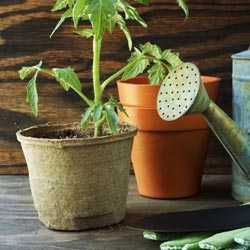 Are you ready to make the most of your vegetable garden? Try these tips and tidbits for everything from easier weeding to stopping pests to enjoying a hearty harvest!
Are you ready to make the most of your vegetable garden? Try these tips and tidbits for everything from easier weeding to stopping pests to enjoying a hearty harvest!
- Reducing Weeds
Minimize weeds in your garden by covering the soil between planting rows with mulch. Several sheets of moistened newspaper topped with hay or straw works very well, especially if you move your planting areas around a bit from year to year. You can even use carpet scraps placed upside-down. Landscape fabric topped with wood chips or gravel is a good choice if the walkways are permanent. Try to avoid the habit of tilling to remove weeds because this process brings up weed seeds from deeper in the soil and exposes them to the light they need to grow. - Increase Tomato and Pepper Production
Fruiting of your tomatoes and peppers may be improved by applying Epsom salts, which contain sulfur and magnesium. Apply one tablespoon of granules around each transplant, or spray a solution of one tablespoon Epsom salts per gallon of water at transplanting, first flowering and fruit set. You can find Epsom salts at drug and grocery stores. - Supporting Tomato Plants
Set your tomato supports in place before plants get too large. Smaller determinate (bushy) varieties can be supported with small cages, but larger indeterminate (vining) varieties need large cages or tall stakes. Secure cages with stakes so they don’t fall over as plants grow larger and heavier. - Growing Larger Tomatoes
Indeterminate tomato plants, such as ‘Better Boy’, will produce many suckers. A sucker is a new shoot that starts where a branch connects with the main trunk. Removing suckers will decrease the number of fruits produced, but the remaining tomatoes will be larger and will ripen sooner. - Ending Blossom End Rot
To minimize blossom end rot, keep soil evenly moist, apply a layer of mulch to conserve moisture, don’t over-fertilize (especially avoid high-nitrogen fertilizer) and avoid damaging plant roots while cultivating. Blossom end rot shows up as dark sunken spots on the blossom or non-stem end of tomatoes, peppers and squash. It’s caused by a calcium imbalance in the plant. The soil may have adequate calcium, but the plant isn’t able to take up enough to supply the rapidly developing fruit. - Stop Slugs and Snails
Slugs and snails may be deterred with coffee grounds, diatomaceous earth and even sharp gravel. Spread any of these materials in a ring around individual plants. Wrap pots with copper tape to keep slugs from crawling up. Inspect foliage and pick off any insects that have already passed the barriers. - Keep Cucumber Beetles at Bay
Young cucumber, melon and squash plants are easy prey for cucumber beetles. As the seedlings grow, these yellow-striped or spotted beetles emerge to feed on their foliage. The beetles also spread bacterial wilt disease. To control cucumber beetles use a portable vacuum cleaner to suck up them up in early evening, spray beneficial nematodes on the soil or try planting broccoli, calendula, catnip, nasturtium, radish, rue or tansy, which naturally repel these insects. If you want to try marigolds to repel them use the more pungent varieties like African, French or Mexican marigolds. The more common marigolds may actually attract these pests. - Plan for Late Summer Harvests
It’s not too late to sow lettuce, beets, carrots, radishes and other short-season crops for a late summer harvest. Shade lettuce, if possible, during late afternoon to keep young plants cooler, or grow them next to larger plants that provide some shade. You’ll need to water more often on these hot days than you did in spring and early summer, but you can easily extend their growing season for later harvesting. - Grow More Tomatoes, Zucchini and Beans
Harvest tomatoes, zucchini, beans and other fruiting crops frequently to encourage continued production. Don’t allow any fruits that you won’t be harvesting to remain on your plants, because when mature seeds are produced it’s a signal for the plant to slow down fruit production. Instead, consider sharing, selling, preserving or trading extra produce so you can continue to harvest and extend the growing season. - When to Harvest Herbs
Herbs are best harvested just as they are beginning to flower. That’s when they have the highest concentration of essential oils and flavor in their leaves. Harvest entire branches back to within a few inches of the main stem to encourage new, bushy growth. - Harvesting and Storing Onions
Begin harvesting onions when about half to three-quarters of the leaves have died back. Then gently dig or pull the onions and store them in a dry, shady place with good ventilation, such as an outdoor shed or barn, for 10-14 days. After the onions have cured, put them in slatted crates or mesh bags and store them indoors in an area with low humidity and temperatures between 33-45 degrees F. - Enjoying Green Tomatoes
When daytime temperatures no longer rise above 65 degrees F in late summer and early fall, it’s time to pick the green tomatoes. Wrap them individually in newspaper and let them ripen indoors, or try some fried or in other recipes that call for under-ripe tomatoes.




